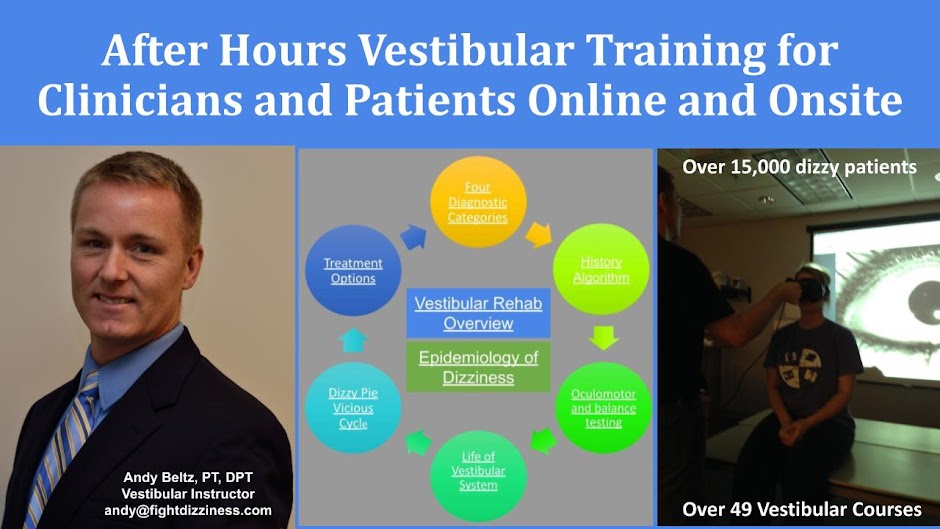Pt example: A 48-year-old with motion sensitivity from an AICA stroke two months prior that caused an inner ear weakness, lack of peripheral vision, poor depth perception, poor movement transition tolerance (like a truck slamming on brakes instead of using the jake brake), and a sense of things having to catch up when turning head. The client had no spontaneous nystagmus, no saccades with smooth pursuit, no dysmetria, hypermetria, or dysdiadokinesia, normal UE/LE strength, scored 56 on Berg and 23 on Functional Gait Assessment as well as walked 860 ft in six minutes independently. DTRs were WNL, and the client had no spasticity or neglect. Was six lines off with dynamic visual acuity testing.
Chief complaints: Unable to drive without getting sick, unable to walk without a sense of being off-balance and slight motion sensitivity, and unable to return to work as a factory supervisor.
Clients key goals: drive without motion sickness to return to work and have a better sense of confidence walking and jogging.
What worked well?: The following chart and symptom guideline helped me progress my client with mixed peripheral and central vestibular dysfunction well. Also, intense one-on-one motivational dizziness neuroscience education with biofeedback-related training helped improve self-efficacy, confidence in general, understanding of safe progression, and optimized proper self-dosing and self-direction of functional training at home.
Symptom severity guideline: I progressed his return to driving and improved confidence jogging program to provoke intense symptoms that would go away in one minute or less and yucky/motion sick feelings to go away in 30 minutes or less as my guide for proper dosing training.
Vestibular training variable progression chart: I used smooth pursuit, saccadic eye movements, convergence, divergence, VOR cancellation, and adaptation exercises while adjusting the following key variables in treatment:
This program allowed me to meet the following main goals listed in the Winstein and Kay article2:
Ensure challenging and meaningful practice (Driving simulation and jogging training progressed, so practice was “repetition without repetition”3).
Address important (interfering) changeable impairments (progressing variables above).
Enhance motor capacity through overload and specificity (functional training pushing motion tolerance daily with dizziness neuroscience education to guide client).
Preserve natural goal-directedness in movement organization (progression of return to driving with dizziness neuroscience education).
Avoid artificial task breakdowns when possible (worked toward sitting in the car and driving activities as quickly as possible as well as walking and jogging).
Assure active patient/participant involvement and opportunities for self-direction (asked him to suggest progression ideas and ways to return to driving quicker through practice. Utilized dizziness neuroscience education to help him learn how to properly progress functional training at home).
Balance immediate and future needs (needed to feel well driving to therapy with wife on back streets before returning to driving to work on own on a busy highway).
Drive task-specific self-confidence high through performance accomplishments (many events were timed for competitive biofeedback, and I provided positive feedback regularly with motivational education regarding his performance).
A few other examples: I used timed ladder walking drills, timed driving tolerance with youtube simulation, and provided positive feedback and motivational dizziness neuroscience education during these events.
“I attest that this submission represents my own work and is compliant with Arcadia’s standards for academic integrity.”
Hall CD, Herdman SJ, Whitney SL, et al. Vestibular Rehabilitation for Peripheral Vestibular Hypofunction: An Evidence-Based Clinical Practice Guideline: FROM THE AMERICAN PHYSICAL THERAPY ASSOCIATION NEUROLOGY SECTION. J Neurol Phys Ther. 2016;40(2):124-155.
Winstein CJ, Kay DB. Translating the science into practice: shaping rehabilitation practice to enhance recovery after brain damage. Prog Brain Res. 2015;218:331-360.
Lee, T. D., Swanson, L. R., & Hall, A. L. (1991). What is repeated in a repetition? Effects of practice conditions on motor skill acquisition. Physical therapy, 71(2), 150–156.

No comments:
Post a Comment